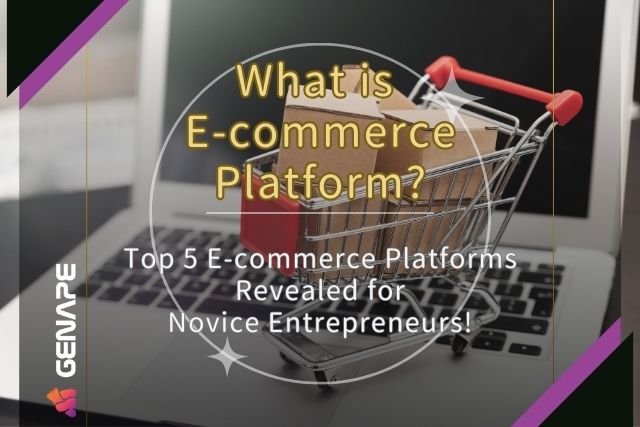Now, being your own boss is no longer just a dream. You can start selling goods simply by registering an e-commerce platform account. But do you know what e-commerce is if you have dreams of entrepreneurship? Or if you already understand e-commerce, do you not know what e-commerce entrepreneurship sells? This article will help you understand what the e-commerce industry is, the four major e-commerce operating models, master the product selection techniques and e-commerce operating strategies. All the key points that e-commerce operation must know are summarized in this article to assist you in achieving your entrepreneurial dreams.
Table of Contents
ToggleWhat is e-commerce? What industry does e-commerce belong to?
E-commerce, short for electronic commerce, is a business model that utilizes the internet to conduct buying and selling of goods or services through Internet. Simply put, it involves buying and selling behavior through the internet. The rise of this business model is due to the development of technology and the internet. Unlike traditional consumer models, companies do not need to establish physical stores to provide products or services to consumers. Consumers can purchase goods without leaving their homes, and the transaction process does not require the use of paper money or coins; transactions can be quickly completed through electronic payment.
How to become an e-commerce entrepreneur? First, understand the four major e-commerce operating models
The advantage of e-commerce lies in its business model being unrestricted by time and location, providing consumers with a more convenient and faster shopping experience. It also reduces the threshold for entrepreneurship, allowing companies to explore new markets and opportunities with less capital expenditure. With the widespread adoption of the internet and continuous technological innovation, e-commerce has developed into different operating models, mainly divided into B2C, C2C, B2B, and C2B. Here are detailed explanations of the four e-commerce operating models:
B2C
B2C, short for Business-to-Customer, is the most common e-commerce operating model. In this model, companies provide goods or services on platforms, and consumers purchase goods or obtain services through these platforms. Examples include Amazon, the world’s largest e-commerce platform, where consumers purchase products from enterprises in different countries. Other B2C e-commerce platforms include CoolPeng and MOMO Shopping Network. Additionally, platforms like GenApe provide consumers with various AI-generated templates for various occasions, including daily and marketing use, such as blog article generation, AIDA advertising framework, AI text generation graphics, and image restoration functions.
Generate an enticing e-commerce product description immediately: https://app.genape.ai/templates/productDescriptions
C2C
C2C, short for Customer-to-Customer, is a model where consumers provide goods or services through platforms and can also purchase goods or services from other consumers. C2C e-commerce platforms allow consumers to meet the theory of supply and demand. For example, eBay allows consumers to sell second-hand or unused new goods through this platform, or find and purchase goods they need. Airbnb allows individuals to provide vacant rooms through the platform for people with short-term accommodation needs.
B2B
B2B, short for Business-to-Business, is a model where a company provides goods or services to other businesses on a platform. For example, businesses can wholesale goods through platforms like Alibaba. Most users of Alibaba are suppliers, wholesalers, or manufacturers. SAP is a business communication platform used between enterprises, providing various enterprise management systems such as Enterprise Resource Planning (ERP), Supply Chain Management, and Customer Relationship Management.
C2B
C2B, short for Customer-to-Business, is a model where businesses can purchase goods or services provided by consumers on a platform. Consumers can publish their works on Upwork, and businesses can acquire cooperation opportunities through bidding. Some stores, in order to improve service quality, can use platforms like Yelp to allow consumers to provide feedback and suggestions.
What to sell when you startup e-commerce?Mastering product selection techniques in e-commerce.
If you’re not a franchise business but rather looking to start your own venture or sell products on e-commerce platforms as a consumer, deciding what products to sell is the first and most crucial step in e-commerce entrepreneurship. Once you’ve decided on your products, you need to develop relevant marketing strategies. If you later find that the products you’ve chosen for your e-commerce venture are not suitable, it can waste a lot of time, effort, and startup funds. Here are some e-commerce product selection techniques to help you determine the most suitable products based on your own conditions:
Your professional field or interests
In e-commerce entrepreneurship, you can choose products related to your own professional field or interests. When you provide products and services, consumers will want to learn more about the products. In this case, they may ask you product-related questions. You need to answer consumers’ questions from a professional perspective so that consumers will trust your e-commerce products. Businesses with expertise or passion for their products can significantly increase consumers’ willingness to purchase.
Handmade crafts
If you’re skilled and adept at making crafts, you can sell handmade crafts in your e-commerce venture. You only need to carefully select material suppliers, without spending time and money searching for contract manufacturers or communicating details with manufacturers. By making products by hand, you can not only save time and costs but also ensure product quality.
Following trends
Selling products related to current trends in e-commerce entrepreneurship can quickly increase exposure. You can make relevant products based on current trends. For example, when the Yellow Rubber Duck visited Kaohsiung, yellow duck headwear became popular throughout Taiwan. By keeping up with trends, you can increase brand awareness. However, it’s important to ensure that the products you make do not infringe on copyrights.
How to startup e-commerce? Understanding e-commerce management strategies
E-commerce management strategies are similar to traditional marketing strategies, but the focus should be on “online consumption.” Here are the 4P strategies of e-commerce management, providing a reference for those who don’t know how to start an e-commerce business:
E-commerce management strategy: Product
Understanding product positioning helps in formulating marketing strategies that align with the product and identifying potential audiences. The disadvantage for businesses in e-commerce is that “consumers can easily and quickly compare products from multiple stores.” Therefore, businesses should establish product positioning, understand the strengths, weaknesses, possible threats, and future opportunities of the product through SWOT analysis, differentiate themselves among similar products, precisely target audiences, and build a stable customer base.
E-commerce management strategy: Place
The logistics methods for e-commerce operations mostly involve store-to-store or home delivery. Therefore, in the 4P marketing strategy of e-commerce management, the focus is on where businesses should operate on e-commerce platforms and the transportation methods of goods, ensuring that products safely reach consumers and providing a good shopping experience.
E-commerce management strategy: Price
Points to consider in e-commerce pricing strategies include product manufacturing costs, e-commerce platform service fees or transaction fees, and product selling prices. Observe the market prices of the products being sold and set reasonable prices that consumers are more likely to accept.
E-commerce management strategy: Promotion
E-commerce operations use internet marketing strategies to attract new customers and retain existing ones. Considerations include how to advertise to reach new customers, whether to launch product discount promotions in conjunction with holidays or e-commerce platform-related activities, and what time to send out business and product information to gain more attention, etc.
Further reading:AI e-commerce management Techniques , Precisely Boosting Marketing Conversion Rates
E-commerce entrepreneurship and management assistant
In addition to formulating marketing strategies, e-commerce management also requires attention-grabbing e-commerce product titles and descriptions. If you don’t have relevant experience or can’t generate traffic no matter what you do, it’s recommended to use GenApe. GenApe provides AI-generated e-commerce product titles and AI-generated e-commerce product descriptions. Simply enter the product name and relevant information, and GenApe will automatically generate attention-grabbing product titles and descriptions that are suitable for the product. Click the link below to immediately try out the powerful e-commerce entrepreneurship and management assistant.









